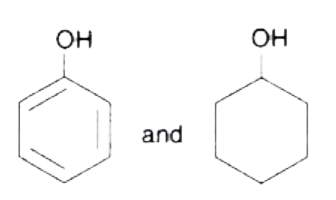Give chemical tests to distinguish between compounds of the following pairs :
Butan-2-ol and 2-methylpropan-2-ol
To distinguish between butan-2-ol and 2-methylpropan-2-ol, we can use the Iodoform test. Here’s a step-by-step solution:
Step 1: Understand the Structures
- Butan-2-ol: The structure is CH3-CH(OH)-CH2-CH3. It has a hydroxyl (-OH) group attached to the second carbon of a four-carbon chain.
- 2-Methylpropan-2-ol: The structure is (CH3)2C(OH)-CH3. It has a hydroxyl (-OH) group attached to a carbon that is also bonded to two methyl groups.
Step 2: Identify the Functional Group
- Both compounds are alcohols, but they differ in their structure and the presence of specific groups that can participate in chemical reactions.
Step 3: Perform the Iodoform Test
- The Iodoform test is used to identify alcohols that have a methyl group adjacent to the hydroxyl group (i.e., the structure CH3CHOH or a methyl ketone).
- Butan-2-ol has the structure CH3-CHOH-CH2-CH3, which contains the required CH3-CHOH group.
- 2-Methylpropan-2-ol does not have this structure; it has a tertiary alcohol structure without the necessary adjacent methyl group.
Step 4: Reaction with Iodine and Sodium Hydroxide
- When butan-2-ol is treated with iodine (I2) in the presence of sodium hydroxide (NaOH), it reacts to form iodoform (CHI3), which is a yellow precipitate.
- The reaction can be summarized as:
Butan-2-ol+I2+NaOH→CHI3(yellow ppt)+other products
- In contrast, when 2-methylpropan-2-ol is treated with the same reagents, no reaction occurs, and no yellow precipitate is formed:
2-Methylpropan-2-ol+I2+NaOH→No reaction
Step 5: Conclusion
- Butan-2-ol gives a positive Iodoform test (yellow precipitate), while 2-methylpropan-2-ol gives a negative Iodoform test (no precipitate). Thus, they can be distinguished based on this test.
---
- Butan-2-ol: The structure is CH3-CH(OH)-CH2-CH3. It has a hydroxyl (-OH) group attached to the second carbon of a four-carbon chain.
- 2-Methylpropan-2-ol: The structure is (CH3)2C(OH)-CH3. It has a hydroxyl (-OH) group attached to a carbon that is also bonded to two methyl groups.
- Both compounds are alcohols, but they differ in their structure and the presence of specific groups that can participate in chemical reactions.
- The Iodoform test is used to identify alcohols that have a methyl group adjacent to the hydroxyl group (i.e., the structure CH3CHOH or a methyl ketone).
- Butan-2-ol has the structure CH3-CHOH-CH2-CH3, which contains the required CH3-CHOH group.
- 2-Methylpropan-2-ol does not have this structure; it has a tertiary alcohol structure without the necessary adjacent methyl group.
- When butan-2-ol is treated with iodine (I2) in the presence of sodium hydroxide (NaOH), it reacts to form iodoform (CHI3), which is a yellow precipitate.
- The reaction can be summarized as:
Butan-2-ol+I2+NaOH→CHI3(yellow ppt)+other products
2-Methylpropan-2-ol+I2+NaOH→No reaction
- Butan-2-ol gives a positive Iodoform test (yellow precipitate), while 2-methylpropan-2-ol gives a negative Iodoform test (no precipitate). Thus, they can be distinguished based on this test.
Topper's Solved these Questions
- ALCOHOLS, PHENOLS AND ETHERS BOOK - ICSECHAPTER - ALCOHOLS, PHENOLS AND ETHERS EXERCISE - EXERCISE (PART-II Descriptive Questions) (LONG ANSWER QUESTIONS)
20 Videos
- ALCOHOLS, PHENOLS AND ETHERS BOOK - ICSECHAPTER - ALCOHOLS, PHENOLS AND ETHERS EXERCISE - ISC EXAMINATION QUESTIONS
25 Videos
- ALCOHOLS, PHENOLS AND ETHERS BOOK - ICSECHAPTER - ALCOHOLS, PHENOLS AND ETHERS EXERCISE - EXERCISE (PART-II Descriptive Questions) (VERY SHORT ANSWER QUESTIONS)
104 Videos
- ALCOHOLS , PHENOLS AND ETHERS BOOK - ICSECHAPTER - ALCOHOLS , PHENOLS AND ETHERS EXERCISE - SOURCE BASED QUESTIONS
4 Videos
- ALDEHYDES, KETONES AND CARBOXYLIC ACIDSBOOK - ICSECHAPTER - ALDEHYDES, KETONES AND CARBOXYLIC ACIDSEXERCISE - EXERCISE (PART-II DESCRIPTIVE QUESTIONS) ( LONG ANSWER QUESTIONS)
478 Videos
Similar Questions
Give chemical tests to distinguish between compounds of the following pairs :
Phenol and benzyl alcohol
View SolutionGive a chemical test to distinguish between each of the following pairs :
Ethane & ethanol
View SolutionGive a chemical test to distinguish between the following pairs of compounds:

View SolutionGive a chemical test to distinguish between each of the following pairs :
Methane & ethyne
View SolutionGive one chemical test to distinguish between the following pairs of compounds :
Ethanol and dimethyl ether
View SolutionGive a chemical test to distinguish between the following gases
HCI and CI2
View SolutionGive chemical tests to distinguish between the following pairs of compounds :
Propanal and propanone.
View SolutionGive one chemical test to distinguish between the following pairs of compounds :
Ethanol and 2 propanol.
View SolutionGive one chemical test to distinguish between the following pairs of compounds :
Ethanol and acetic acid
View SolutionGive a chemical test to distinguish between the following pairs of compounds:
Ethanol and ethanoic acid.
View Solution
